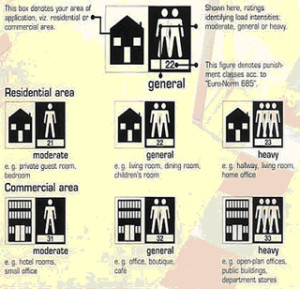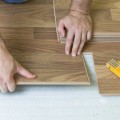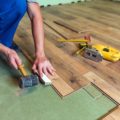Frequently Asked Questions about Laminate Floors
- What are laminate floors and how are they made?
- What is the difference between laminate flooring and hardwood flooring?
- How do laminate floor panels lock together?
- Where can I install laminate flooring?
- What are the advantages of laminate flooring over those of solid hardwood flooring?
- What do I need to know before I start installing my laminate floor?
- What do I have to do before installation?
- Do I have to keep staggering the planks in my laminate flooring installation?
- How do I determine the direction in which to install my laminate flooring?
- Will there be any cutting waste?
- What is the reason for the necessary 10mm gap left around the perimeter of the interior and around other obstacles within it?
- I didn’t get my first row straight. Can I continue?
- How do I choose the right moldings?
- How should I install moldings?
- What is a floating floor?
- What is HDF and what is it made of?
- How is the paper applied to the HDF core?
- Why is a moisture barrier used on concrete?
- How can I get the shine of my floor to increase?
- Can laminate flooring be installed on steps?
- Can laminate flooring be installed in my screened in porch or patio?
- Can we install laminate over carpet?
- How often do the wood grain patterns repeat on your flooring?
- How do I clean my laminate flooring?
- How do I care for and maintain my laminate floors?
- How do I repair minor scratches?
- What is the difference between a brown core and a green core in laminate flooring?
- How do I replace one plank of my flooring due to damage?
- What is a laminate flooring AC rating?
What are laminate floors and how are they made?
Laminate flooring is a versatile, durable, attractive flooring product that can take on several different appearances like stone or tile but it’s known mostly for looking like hardwood. Although they look the same, there is actually no solid wood used in the construction of a laminate floor. Laminates are made up of several layers of material fused together under high pressure. Most laminate flooring consists of a moisture resistant layer under a layer of HDF (high-density fiberboard) or MDF (medium-density fiberboard). This is topped with a high-resolution photographic image of a natural wood floor. It is then finished with an extremely hard, clear coating made from special resin-coated cellulose to protect it from wear and tear. Laminate flooring is perfect for anyone wanting a durable floor for a fraction of the price and installation time of a hardwood floor, but with the attractiveness of real hardwood. Laminate is also environment-friendly as it uses less wood in its construction and makes more efficient use of the wood fiber that is used.
What is the difference between hardwood and laminate flooring?
Both laminate and hardwood flooring can be used to finish homes or provide flooring for offices and businesses. While some people still prefer hardwood, there are several advantages to choosing laminate. Solid hardwood (usually 3/4″ thick) must be installed only above grade to avoid warping and cupping. Laminates, however, are more versatile giving you the look of wood above or below grade. Unlike hardwood, they can be installed over other flooring surfaces, meaning that you can install laminate over old kitchen linoleum or tile, provided the floor is clean, level and doesn’t have moisture problems.
How do laminate floor panels lock together?
There are many types of edge joining systems used to connect laminate flooring panels together, but most of them use a snap lock mechanism. Some snap together laminate flooring, snap together by hand while others require a light tap with a mallet and a tapping block. Still others use a combination of a “snap” click edge and a “bang” or “tap” click at the end of the panels. While most of the various systems work well to secure your laminate floor, it is important to carefully read your laminate flooring installation instructions. Familiarize yourself with how your flooring locks together before starting your installation and practice on a few pieces.
Where can I install laminate flooring?
Laminate flooring is an extremely versatile flooring product. It can be installed in virtually any room of your home, above or below ground, over wood or concrete. Keep in mind there are several locations that are not recommended. Because laminate flooring is a wood flooring product it is not recommended that laminates be installed in wet locations such as bathrooms, washrooms, saunas, enclosed porches or verandas, or anywhere that may require wet mopping. Extended exposure to moisture of this type may cause the core of your laminate flooring to warp or swell. Unless, of course, it’s waterproof laminate.
In some instances, with special installation procedures, it is possible to install laminate floors in bathrooms where water will not stand on the floor for any length of time. Other than that, laminate is very versatile: install it in living and dining rooms, kitchens, hallways, foyers, bedrooms, basements, stairs, offices, retail spaces and many other locations.
What are the advantages of laminate flooring over those of solid hardwood flooring?
Price. Laminate flooring is typically half the cost of traditional hardwood flooring. Sometimes the savings are even greater, depending on the type of flooring in question. And with recent innovations in technology, laminates look more and more like real wood. Laminate is easier to install than solid hardwood and many people can install it themselves without any previous carpentry experience whereas solid hardwood requires a specific level of expertise. With a laminate you won’t need nails and/or glue, as is the case with newer laminate locking systems. Therefore installation happens fast, in way less time than solid hardwoods can be installed and your finished floor will be scratch- and fade-resistant, two areas where solid hardwood is known to be more vulnerable. Whether you choose hardwood or laminate flooring will also depend on personal taste.
What do I need to know before I start installing my laminate floor?
Think about this before you begin your laminate floor installation:
- Ensure that your subfloor is flat, dry, and smooth.
- Always use underlayment under your laminate floor for soundproofing. Some laminates have underlayment built into the bottom layer, if not, find a good one.
- Laminate flooring and underlayment/vapor barrier can be installed over concrete, wood flooring, vinyl tile, linoleum, tile, or virtually any other hard, flat surface.
- Take extra care when installing laminate flooring over radiant heating. Ensure that you read both the laminate flooring and radiant heat system instructions carefully before beginning.
- Read your laminate flooring manufacturer’s installation instructions carefully.
- Allow your laminate flooring to acclimatize to the room where it will be installed for as long as possible (at least 48 hours) by opening the boxes and letting the laminate stay, uninstalled, in the room.
- Inspect each laminate flooring panel carefully for defects or damage before installing it.
What do I have to do before installation?
You must acclimate your laminate boards for 48 hours in the room where they will be installed. That means to open the boxes and let the laminate boards adjust to their surroundings. Installation should take place at room temperature of at least 65°F (15°C). A floor surface temperature of 59°F and an overall room temperature of 64°F must be ensured before, during and three days after the installation.
Do I have to keep staggering the planks in my laminate flooring installation?
The first row should be started with a full plank, the second row with a 2/3 plank and the third row with a 1/3 plank. The distance between joints from one row to the next for the remainder of the installation must be 8″ or greater.
How do I determine the direction in which to install my laminate flooring?
To decide where to begin the layout of your floor, consider incoming light. It is usually best to install laminate flooring with the planks running parallel to light coming in windows or glass doors. For any installation, the starting wall should be as long and straight as possible.
Will there be any cutting waste?
In an average installation, approximately 7% to 10% of the total area to be covered will be wasted for several reasons, typically cuts, planks damaged during installation, or errors.
What is the reason for the necessary 10mm gap left around the perimeter of the interior and around other obstacles within it?
Since the laminate core is derived from wood, it is subject to expansion caused by room temperatures and humidity levels. An expansion gap is a necessary part of any successful installation because it allows space for the expansion of the floor as it responds to these external influences of temperature and humidity. When it is exposed to warmer temperatures, or to increased humidity, laminate flooring planks expand outward. Leaving out the essential element of an outside gap can cause the buckling of the individual laminate flooring planks as the planks push outward against walls or other obstacles.
I didn’t get my first row straight. Can I continue?
Do not continue. Getting the first row absolutely straight is the foundation – perhaps the most critical part- to a successful installation. If your first rows are not properly aligned, or the joints are not tightly sealed, the entire installation will be compromised. (The error will magnify as you continue installing.) All planks must be parallel to each other along both sides and ends or there will be wedge-shaped gaps between planks. If residue is caught in the grooves, poor alignment can also result. Remember to make sure all grooves are clean before installation.
How do I choose the right moldings?
Here is a brief guide to moldings and their best uses for a laminate flooring project:
How should I install moldings?
You can glue or nail moldings to the wall only, never to the floor.
What is a floating floor?
A floating floor is a floor built with all its parts attached, but with none of these parts fixed to the supporting floor. Virtually all laminate floors install as floating floors.
What is HDF and what is it made of?
High density fiberboard, HDF, is basically a high-density, moisture-resistant fiber panel. It is made of wood residues (sawdust, shavings and wood chips) from wood processing factories. This ligneous material is ground into a pulp to which a melamine-urea-formaldehyde resin is added. This pulp is then dried and pressed into panels.
How is the paper applied to the HDF core?
The melamine impregnated paper is thermo-fused to the core, topped with an aluminum-oxide wear layer.
Why is a moisture barrier used on concrete?
Concrete floors below ground are capable of storing a vast amount of water. It is crucial to avoid all direct contact between the laminate flooring and the concrete floor because the soil beneath the concrete can transmit humidity into the floor. Installing a moisture barrier over all concrete surfaces is mandatory for a successful installation and for the ongoing life of your laminate floor.
How can I get the shine of my floor to increase?
The shine can not be modified as it is a manufactured characteristic. Therefore, you must never wax or polish a laminate floor.
Can laminate flooring be installed on steps?
Yes, laminate flooring can be installed on steps but with this exceptional installation, the planks should be glued down with regular wood glue. In fact, laminate is a good stair flooring option. However, the moldings and transitions need to be nailed down. You must also ensure this meets your local building code.
Can laminate flooring be installed in my screened-in porch or patio?
No, laminate flooring must be installed in a climate-controlled area.
Can we install laminate over carpet?
No, all carpet and padding should be removed completely prior to installation.
How often do the wood grain patterns repeat on your flooring?
The patterns repeat every 20 planks.
How do I clean my laminate flooring?
Laminate flooring is a beautiful, low maintenance, long-lasting flooring option. There are several simple steps that you can take to keep your laminate flooring clean and to ensure that you get many years of service from it. Simply dust mop or vacuum with a soft brush or wood floor accessory to keep your laminate floor clean from dust, dirt or grit.
- A damp cloth or mop can be used without damage to the laminate flooring panels, but do not use excessive water. Dry the floor thoroughly with a clean, soft cloth.
- Blot up spills or water from wet feet or footwear immediately with a clean, dry cloth, sponge, or paper towel. Do not allow excess liquid to remain on the surface of your laminate floor.
- Do not use soap-based detergents, abrasive cleaners, or combined “clean and shine” products on your laminate floor.
- Do not use steel wool or other scouring pads that may scratch laminate panels.
- Do not wax or polish your laminate flooring.
- Do not steam clean or use chemicals that may damage the laminate flooring surface.
For stubborn spots or stains on laminate flooring use acetone or nail polish remover on stubborn substances such as tar, asphalt, paint, or oil. Then wipe clean with a damp cloth.
How do I care for and maintain my laminate floors?
While laminate floors are highly resistant to stains and abrasions, they are not indestructible. In order to maximize the durability and beauty of your laminate flooring, we recommend the following practices as part of your floor’s normal care and maintenance.
- Place a doormat outside the exterior entrances to collect excess moisture, sand, grit and other potentially damaging substances from being tracked onto your laminate floor.
- Use only colorfast and non-scratch carpeting or pads on your laminate surface.
- Avoid sharp or pointed objects with concentrated weight such as high heels on your laminate flooring.
- Use protective felt pads under furniture legs or wide castors under appliance levelers.
- Do not slide furniture or appliances across your laminate floor. If using a wheeled dolly to move furniture or appliances, place a clean sheet of smooth plywood or another protective layer over your laminate surface.
- Rearrange furniture occasionally for increased indentation resistance.
- Do not treat or seal your laminate floor panels after they are installed.
- Never sand, lacquer, or refinish your laminate flooring surfaces.
How do I repair minor scratches?
Minor scratches or nicks can be repaired with laminate floor repair paste. This can be purchased in most retail flooring stores.
What is the difference between a brown core and a green core in laminate flooring?
The cores are the same. The green product is a result of a coloring agent added to the adhesive in the manufacturing of the High-Density Fiberboard (HDF) core in response to general market preference.
How do I replace one plank of my flooring due to damage?
If the plank that needs replacing is close to the edge of the room, simply disassemble the floor to the position of the plank to be replaced and then reinstall the plank(s). There is a more complicated procedure if you need to replace a single hard-to-get-to plank. It’s best to call the company you bought the flooring from and ask to speak to a product specialist for specific instructions.
What is a laminate flooring AC rating?
AC hardness ratings are a standardized measure adopted by The Association of European Producers of Laminate Flooring (ELPF). The AC measure rates abrasion resistance, impact resistance, resistance to staining and cigarette burns, and thickness swelling along edges. If a laminate floor cannot meet the requirements for each of these ratings, approval for a given AC rating will be denied. AC ratings 4 and 5 are equally suitable for residential use as AC3 but somewhat more suitable for high traffic commercial applications. AC ratings below 3 are recommended for low traffic residential use only. Here is a more detailed guide:












Lavell Mooney
moved into our new home last October, had vinyl laminate flooring all on our house. I picked the darker. I am very displeased with it, very pretty, but it is a pain to keep clean. Just my husband and I, I see dust and everything on it. It scratches leaves dents, I have things under all my furniture. I wished I had stayed with tile, too late now. It is a 2100 square ft.
Julie
@Jan:
Laminate flooring is only able to withstand the occasional spill that is wiped up immediately. Varnishing it won’t help because 1. It won’t adhere well to the laminate coating and 2. Laminate is better at resisting spills than a varnished surface. Linoleum or tile is a better choice when you have cats that don’t use the litter box.
Phyllis Poole
I would like to see answers to many of these problems because I am thinking of putting down laminate flooring. Where can I find them?
Jan
I have laminate floors, not wood, but the plastic look alike wood type. I also have many cats, who apparently like to pee on the floor as well as in their litter boxes. the planks are NOT liquid proof I have sadly discovered, and the affected planks have swelled to the point that I will be replacing them with spare planks from the first installation…
here’s’ my question: should I have covered the entire floor with clear varnish or a similar substance to avoid this damage in the 1st place? this has been an ongoing argument with hubby since day 1,
~~ I still think it would have prevented the urine damage..
can someone please answer my question?
thank you!
Lorraine Henderson
Okay – my sister is confined to a wheelchair (not motorized) and I have had two suggestions for the transitions – the usual one that you have and someone else suggested a metal strip that would allow the wheelchair to get over easily. Which would be best?
Tina
Just built a house. 1 week old. Put wood laminate throughout. was told by an employee at home depot that I shouldn’t put down any area rugs for at least a year, as the laminate will change color. Is this true???
Dominique
Can I mix match my laminate floor with different colors?
Haley
For the three people that asked about laminate noises: I Googled that for you. Try doing a little research, it’s not that hard. It took me all of ten minutes. The most likely reason they didn’t answer your question is because there are several different reasons for the noises and they have ABSOLUTELY no way of knowing what your problem is. Also, they didn’t answer some of the other questions either, so it’s not like they’re picking on you (Barbara Kluko). The third link below is perhaps the most interesting, but they all make valid points.
//www.askmehelpdesk.com/other-home-garden/laminate-floor-making-popping-noises-97905.html
//www.hardwoodflooringtalk.com/forum/laminate-flooring-noises-t7924.html
//www.ar15.com/forums/t_1_5/802315__HOME_REPAIR__Popping_on_new_laminate_floor.html
//www.doityourself.com/forum/solid-hardwood-engineered-laminate-flooring/327340-noise-when-walking-laminate-floor.html#b
barbara kluko
Three people asked the same question and you did not answer them. You answered everyone else but them. I too have the same question which is “laminate flooring started to make crackling or popping noises (like rice crispies). What is causing this and what should I do?”
Is there some reason that this is the only questions not being answered? Please answer this and if you do not know, please just say so.
larry
Nothing said about potential bowing or bending of the pergo when installed, after the concentrated weight of furniture (esp couches with people on same) double beds with
their 4 ‘small’ supports each corner, with two 150 to 200# persons on same, and the
resulting bowing of the pergo. TIA Larry
Mark bingham
Can I use laminate over top of a concrete floor with core floor radiant heating? if so, which is better 8mm or 12 mm?
BOB HUTSELL
SIR I WANT TO PUT IN A LAMINATE FLOOR I NOW HAVE A TILE FLOOR CAN I PUT THE LAMINATE FLOOR OVER THE TILE ARE DO I NEED TO REMOVE THE TILE FIRST WHICH IS GLUED DOWN THANK YOU
BOB
janice la pierre
i have had laminated floor in mt kitchen for seven years no problems what so ever ,last year i had it installed in my hall and spare room still no problems ,on the week-end i had it unstalled in the master bedroom,here’s hoping the third installation will be as good as the first too.
verna
I also have that popcorn sound as well.
verna
I have laminate flooring for two years. I just noticed the edges are turned green in fron of my living room window. I was told that it would not fade with the sun. What is the problem?
Thank you
Charlie
You should spell check everything before you post it.
I believe this is supposed to read Do not continue. Getting the first row absolutely straight *as the foundation – perhaps the most critical
Do not continue. Getting the first row absolutely straight is the foundation – perhaps the most critical
Forrest
It’s recommended that a laminate floor be put down in the opposite direction of the floor joints, is that necessary if you have a solid plywood sub-floor. Also if there is a 3/4″ space between the sub-floor and the baseboard is there a thicker underlayment I can place under the laminated flooring to bring it closer to the baseboard. Thanks.
Scott
Hi, I just installed a laminate floor in my kitchen. I was wondering if you could seal the floor to keep spills and water from getting to the floor? If you can is there a particular product you recommend?
Thanks, Scott
Wally Schrade
We just installed a laminated floor in our Kitchen and we wondering what is the best tips to use on the legs of our wood chairs so we don’t scratch the floor. We each weight over 300 lbs.
Rodney Noriega
Hi Wally,
While laminate can be highly resistant to stains and abrasions, it is not indestructible. I suggest the folloing to maintain the durability and beauty of your floor:
-Use protective felt pads under furniture legs or wide castors under appliances levelers. (In reference to your question)
-Place a doormat outside the exterior entrances to collect excess moisture, sand, grit and other potentially damaging substances from being tracked onto your laminate floor.
-Use only colorfast and non-scratch carpeting or pads on your laminate surface. Avoid
-If using a wheeled dolly to move furniture or appliances on your laminate floor, place a clean sheet of smooth plywood or other protective layer over your laminate surface.
Hope that helps!
Rodney
Olga
I HAD LAMINATE FLOORING INSTALLED 2 YEARS AGO. IT HAS STARTED TO MAKE POPPING OR CRACKLING NOISES WHEN WE WALK ON IT. (LIKE RICE CRISPIES) ANY IDEA HOW I COULD SOLVE THIS PROBLEM?????
Thanks
Barbara
I HAD LAMINATE FLOORING INSTALLED 2 YEARS AGO. IT HAS STARTED TO MAKE POPPING OR CRACKLING NOISES WHEN WE WALK ON IT. (LIKE RICE CRISPIES) ANY IDEA WHAT TO DO OR WHAT HAPENED?
john kavemeier
what effects will a dry sauna have on a laminated hardwoon floor
Jim
What is the longest length of room that this can be installed in without using ‘T’ strips? (eg, I’ve read 27 ft upto 49 ft elsewhere for various brands)
Sherryn Postlewait
I am thinking about installing laminate flooring, but my husband is in a motorized wheelchair. What AC should we install or should we install other flooring?
Pingback: Choosing a floor 5 Reasons to buy luxury vinyl tile flooring | BuildDirect Blog